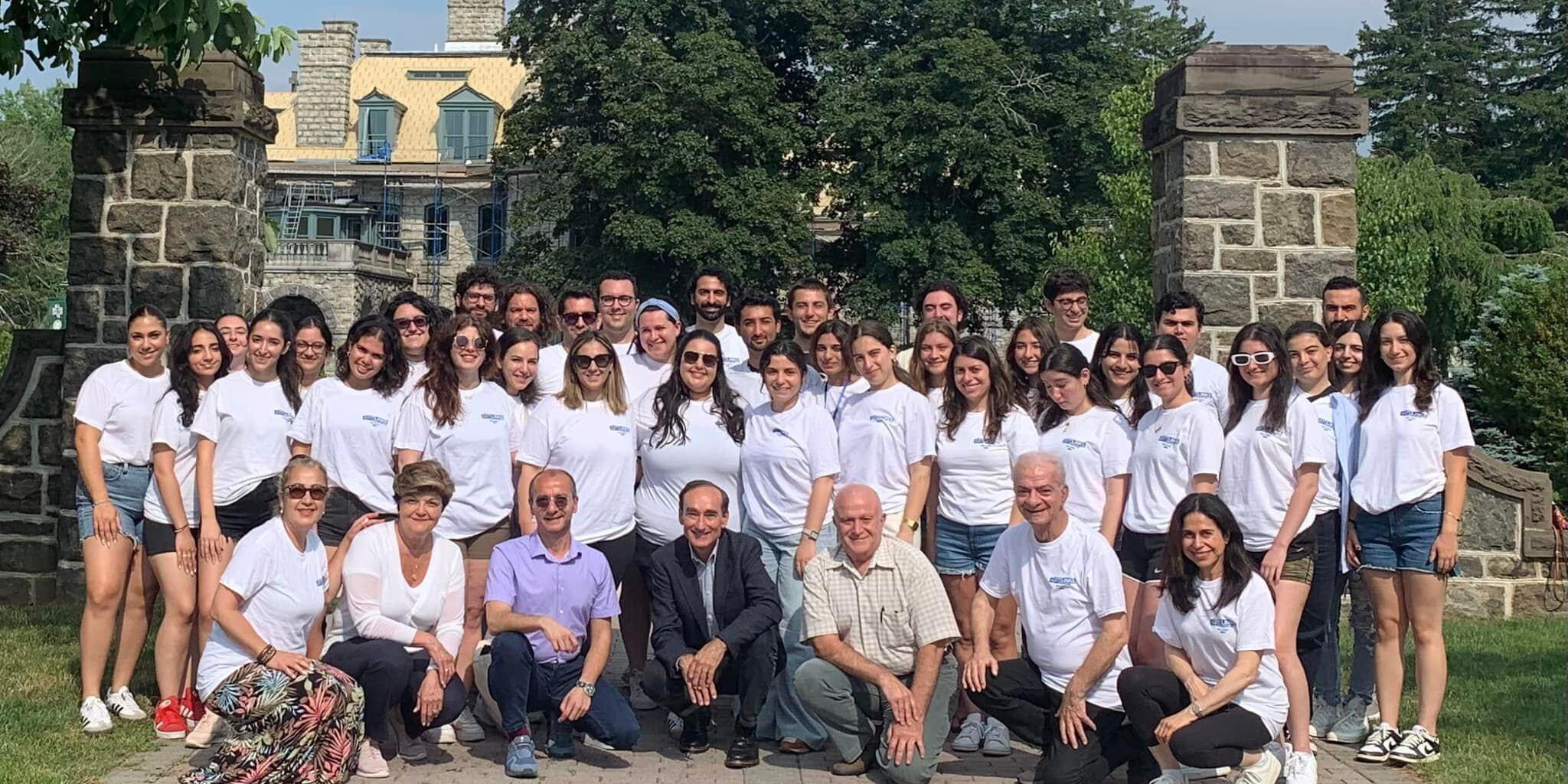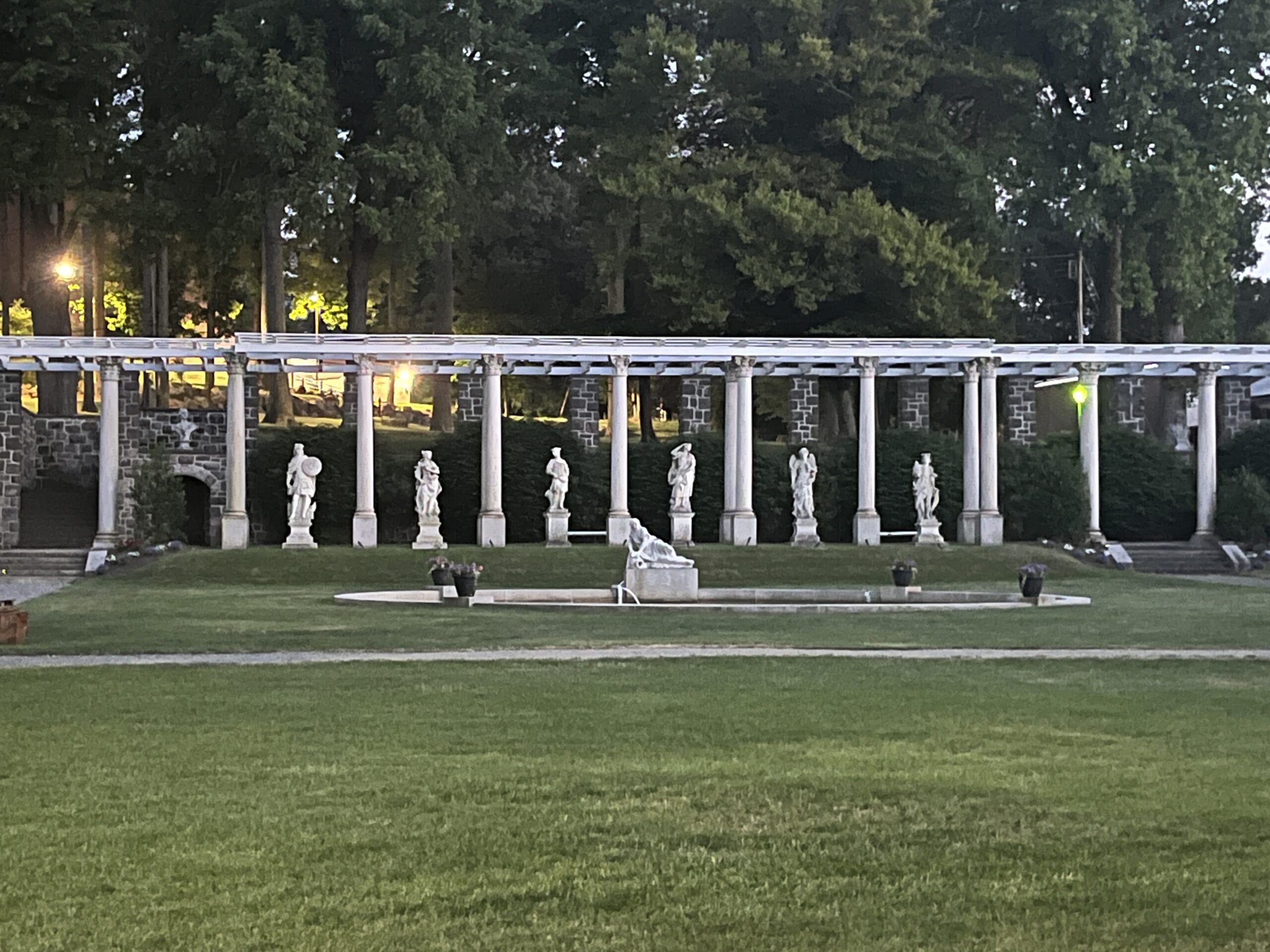On Thursday, June 20, a group of young Armenians from across the United States and Canada arrived at St. Mary’s Abbey in Morristown, New Jersey for Hamazkayin ArtLinks weekend.
The beautiful abbey campus features tons of greenery and a collection of ancient statues. We all stayed in the retreat center, which used to be a dorm building when the abbey was once a school for boys, so we had spacious rooms and a large common area to gather and chat at the end of the day. We spent time between the retreat center, the dining hall and the library. The dining hall was lovely and became another place of shared community, as we talked to each other across the long tables.
This year, ArtLinks featured six sessions with subjects ranging across history, technology and the arts. Our first workshop on Friday morning was led by voice actor, singer, puppeteer and fellow ArtLinks participant Liana Bdéwi. She shared the journey of her career, from building her own voice studio at home to voicing the goddess Astghik in the “Vardavar!” episode of Disney’s Mickey Mouse Funhouse. Bdéwi was upfront about the many challenges and responsibilities of working in the arts, but also offered advice and encouragement for anyone interested in this career path. Her story gave me some insight into a field I wasn’t familiar with. I half-want to build my own cheap voice studio now and record some audiobooks, just for fun.

Bdéwi also gave us a lesson in voice acting. She taught us the basics of scriptwork, which involves using the script (and a bit of imagination) to answer questions about characters, such as: Who am I? Who am I speaking to? What do I want? As someone interested in creative writing, I noticed a bit of overlap between these different art forms. A voice actor asks these questions so they can embody the character with their voice, and a creative writer asks the same questions so they can embody the character through their writing. The scriptwriter puts the answers to these character questions in the writing, and the voice actor finds them and brings them to life.
Then we moved on to actual performance. Bdéwi handed out scripts for short scenes. Each pair or group of three worked together to answer character questions, develop backstories and choose an active intention behind each spoken line. We practiced on Friday, and on Sunday morning, the library became our stage as we brought our scenes to life. Some groups ended up having completely different performances based on their interpretations of the same script. While the performances were a lot of fun, Bdéwi made it clear that the skills we practiced are useful to more than just actors. Knowing how to convey emotion and intention through tone, confidently project to an audience and improvise off of another’s energy are all important for public speaking, networking and everyday socializing.
The next session focused on the rising power of technology. On Friday afternoon, Vatche Isahagian, a senior research scientist at IBM Research, presented on artificial intelligence (AI). The controversy around AI has increased with the emergence of generative AI that creates text, images or even video with only a prompt.

Isahagian walked us through the training process for ChatGPT, a type of generative AI. The model predicts what word comes next in a sentence, a human trainer marks it as correct or incorrect, and the model makes a connection. ChatGPT-4 passed the U.S. bar exam and medical license exam (super impressive!) but somehow only got a 2 (out of 5) on the AP English Language exam — frankly embarrassing for a language model. You had one job, GPT!
The emergence of AI creates a host of problems, such as hallucinating (or when AI says things that are just plain wrong) plagiarism, scams, biases, ethical problems and industry impacts, particularly in the arts.
Well, that all sounds bad. As an aspiring creative writer, the threat to the creative arts makes me nervous. One day, art may be created, not by a human with purpose and passion, but by a robot with lots of guesswork and other people’s data. I want to make art my career so I can dedicate time to it and share it with others. If I lose an opportunity, I want it to go to someone else with the same dreams — someone who deserves to tell their story, not a model regurgitating whatever will make it a NYT bestseller.
Yet after this presentation, I’ve formed some new opinions on the benefits of generative AI as well. For instance, AI automating jobs can take over tedious work and increase productivity. AI would also create some new jobs, since it needs humans to monitor, train, program and direct it. Finally, accessibility is the true purpose of AI: it helps people do what they otherwise could not. Generative AI can be a beneficial tool to people who have disabilities, are learning a new language or just need some extra help, for example.
I came away from Isahagian’s presentation fascinated by this topic far outside my usual interests. Isahagian’s clear knowledge of and passion for his work were engaging and insightful. He weathered my many questions during the presentation and into dinner, where the discussion continued.
But the day wasn’t over yet! After dinner, we pushed aside the cafeteria tables to clear the floor for our third session, presented by the Hamazkayin Nayiri Dance Ensemble of New Jersey. After an incredible performance of Armenian (and one Greek!) dances, everyone came together in a huge circle to dance together. Ensemble director Barkev Sanossian led us through the steps. This workshop reminded me of what I love most about Armenian dance. Practiced dancers like the Nayiri Ensemble develop the skills to perform with grace and elegance, but most of the traditional dance steps are simple enough that anyone can participate.
The next morning, we met for the fourth workshop. Dr. Roberta Ervine, professor of Armenian Christian Studies at St. Nerses Armenian Seminary, delivered a lecture titled “Doors in Time and Space: Armenian Khach’k’ars and Other Stone Crosses.” She began: “I want to talk about the Armenian fascination with rocks.”
Stonework is a widespread art in Armenia. Khachkars are stones carved with the image of the cross. They can be found leaning against the walls of churches, marking graves, acting as warning signs, commemorating events, standing as a part of a church’s walls or being altars themselves. Spiritually, they are the cross — there is no separation between the khachkar and what it represents. Through their long history, khachkars became synonymous with the cross, and the cross became the beating heart of Armenian spirituality.

The making of khachkars is a sacred art that reflects the spiritual values of the artist. Common symbols include stairs and doors representing the path to heaven, vines representing unbreakable eternity, the number six representing earth’s days of work and the number eight representing an eighth day beyond earthly time.
Dr. Ervine possesses an astonishing wealth of Armenian cultural and historical knowledge. I would have loved to hear any related stories, side tangents or any other depths of history she could discuss. Luckily, I found she has a number of recorded lectures up on YouTube — I’ll be checking those out, and if this seems interesting, I recommend you do too! Regardless, I’m so grateful that I could learn from her in person about such a sacred art in our culture.
On Saturday afternoon, bestselling author and playwright Chris Bohjalian led a creative writing workshop for our fifth session. He offered industry advice and shared some of his personal process, but the main focus of the workshop was on simply starting to write. He taught us that there are only two things you need to know before you start writing: a narrator (first or third person, or second person with good reason) and a tense (present or past). Once you pick a narrator and a tense — each comes with its own benefits and drawbacks, so choose wisely — you can start putting the words down, and the rest will come.

Beforehand I had figured this session would be my favorite workshop, and I was unsurprised to be right. As creative writing is my passion, Bohjalian’s workshop was the most interesting to me and relevant to my future work. My biggest struggle in writing is getting started, so I took a lot away from Bohjalian’s advice.
As Sunday morning spilled into afternoon, program director Khatchig Mouradian gave his closing remarks. “Thank you all for being part of this program — it was wonderful,” he said. “This was one of our best groups. I already have a couple of ideas about who’s going to follow Liana as workshop leaders in the next couple years from this crowd. For me it has been also extremely enriching just thinking about the four or five workshops we had, the interactions we had with the speakers, and how inspirational it all was.”
Hamazkayin Central Board representative at ArtLinks Viken Tufenkjian gave the last words of the weekend, with which I wholeheartedly agree. “I would like to state, on behalf of all of you, that Khatchig did an exceptional job this year,” he said. “Personally, I especially like the balance he struck between the cultural and the almost scientific — the AI, the creative writing and where they cross. So once again, thank you Khatchig, for everything.”
I loved the opportunity ArtLinks provided for me to learn about many subjects directly from experts. However, equally impactful was the time I spent making friends and sharing in Armenian culture. I don’t often have the opportunity to meet other Armenian creatives around my age. At ArtLinks, I did, but I was also shown just how little of my own culture I know. I don’t speak any Armenian, I didn’t know the songs everyone sang together late one night, and I was a useless team member for the Armenian trivia game. But I never felt less-than for this. Everyone around me was accepting: translating for me, teaching me some basic Armenian, and switching to English when they realized I couldn’t understand. I wasn’t used to being part of a tight-knit community like this, but when we were all together that weekend, I felt at home.
Thanks so much to the organizers and fellow participants I had the honor of spending time with this year. You’ve made this weekend one I’ll remember my entire life. I hope to see you all at ArtLinks next summer!
Source:
https://armenianweekly.com/2024/07/17/hamazkayin-artlinks-fosters-a-community-that-feels-like-home/


